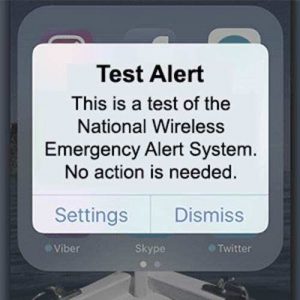FEMA, in coordination with the Federal Communications Commission, will conduct a nationwide test of the Emergency Alert System (EAS) and Wireless Emergency Alerts (WEA) this afternoon.
 The national test will consist of two portions, testing WEA and EAS capabilities. Both tests will begin at 2:20 p.m. ET on Wednesday, August 11,2021
The national test will consist of two portions, testing WEA and EAS capabilities. Both tests will begin at 2:20 p.m. ET on Wednesday, August 11,2021
The Wireless Emergency Alert portion of the test will be directed only to consumer cell phones where the subscriber has opted-in to receive test messages. This will be the second nationwide WEA test, but the first nationwide WEA test on a consumer opt-in basis. The test message will display in either English or in Spanish, depending on the language settings of the wireless handset.
The Emergency Alert System portion of the test will be sent to radios and televisions. This will be the sixth nationwide EAS test.
FEMA and the FCC are coordinating with EAS participants, wireless providers, emergency managers and other stakeholders in preparation for this national test to minimize confusion and to maximize the public safety value of the test. The test is intended to ensure public safety officials have the methods and systems that will deliver urgent alerts and warnings to the public in times of an emergency or disaster.
Major information about the test includes:
- The purpose of the Aug. 11 test is to ensure that the EAS and WEA systems continue to be effective means of warning the public about emergencies, particularly those on the national level. Periodic testing of public alert and warning systems helps to assess the operational readiness of alerting infrastructure and to identify any needed technological and administrative improvements.
- The WEA portion of the test will be initiated using FEMA’s Integrated Public Alert and Warning System (IPAWS), a centralized internet-based system administered by FEMA that enables authorities to send authenticated emergency messages to the public through multiple communications networks. The WEA test will be administered via a code that alerts only phones that have opted in to receive WEA test messages. The EAS portion of the test will be initiated using FEMA-designated Primary Entry Point stations.
- In case the Aug. 11 test is canceled due to widespread severe weather or other significant events, a back-up testing date is scheduled for Aug. 25.
Anyone who has opted in to receive test messages on their wireless phone will receive the message only once. The following can be expected from the nationwide test:
- Beginning at 2:20 p.m. ET, cell towers will broadcast the test for approximately 30 minutes. During this time, WEA-compatible wireless phones where the subscriber has opted-in to receive test messages, that are switched on, within range of an active cell tower and whose wireless provider participates in WEA, should be capable of receiving the test message. Wireless phones should receive the message only once.
- For consumers who have opted in to receive WEA test messages, the message that appears on their phones will read: “THIS IS A TEST of the National Wireless Emergency Alert System. No action is needed.”
- Opt-in phones with the main menu set to Spanish will display: “ESTA ES UNA PRUEBA del Sistema Nacional de Alerta de Emergencia. No se necesita acción.”
- Launched in 2012, WEA is a tool for authorized government agencies to reach the American public during times of national emergency. It is used locally to warn the public about dangerous weather, missing children, and other critical situations through alerts on cell phones.
- Alerts are created and sent by authorized federal, state, local, tribal and territorial government agencies through IPAWS to participating wireless providers, which deliver the alerts to compatible handsets in geo-targeted areas.
- To help ensure that these alerts are accessible to the entire public, including people with disabilities, the alerts are accompanied by a unique tone and vibration. The test handling code will allow FEMA to test this capability while limiting test messages to those phones that have opted in to receive test messages.
- The EAS portion of the test is scheduled to last approximately one minute and will be conducted with the participation of radio and television broadcasters, cable systems, satellite radio and television providers and wireline video providers (EAS participants).
Other important information about the EAS test:
- The test message will be similar to the regular monthly EAS test messages with which the public is familiar. It will state: “THIS IS A TEST of the National Emergency Alert System. This system was developed by broadcast and cable operators in voluntary cooperation with the Federal Emergency Management Agency, the Federal Communications Commission, and local authorities to keep you informed in the event of an emergency. If this had been an actual emergency an official message would have followed the tone alert you heard at the start of this message. No action is required.”
- Emergency alerts are created and sent by authorized federal, state, local, tribal and territorial government agencies. EAS participants receive the alerts through IPAWS or through local “over-the-air” monitoring sources. EAS participants then disseminate the emergency alerts to affected communities.



